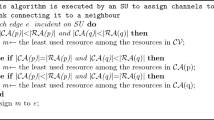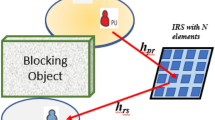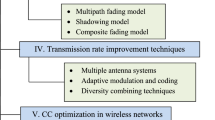Abstract
This paper investigates the secrecy outage performance of underlay cognitive radio networks, in which a source in a secondary system transmits its confidential information to a legitimate destination in the presence of an eavesdropper. Specifically, the main (the source-to-destination) and eavesdropping (the sourceto- eavesdropper) channels are assumed to be correlated. Moreover, it is also assumed that the main channel and the channel from the source to the primary user’s receiver are correlated. Tight closed-form analytical expression for secrecy outage probability and the closed-form analytical expression for the probability of non-zero secrecy capacity are derived and validated by simulation results when the interference temperature limit is comparably large.
摘要
创新点
-
1)
在相关瑞利衰落信道中, 我们推导出保密中断概率的紧凑闭合表达式. 从仿真结果中, 我们发现当干扰温度阀值相对较大时, 所推导出的近似表达式是准确的.
-
2)
同时, 我们也推导出非零安全容量概率的解析表达式。
中文摘要
本文研究了下垫式认知无线电网络的保密中断性能. 在此系统中, 次级系统的信源发送保密信息到合法用户, 同时此信息被窃听者窃听. 在考虑了主信道 (信源到信宿) 和窃听信道 (信源到窃听者) 具有一定的相关性和主信道与信源到主用户接收端的信道也具有相关性的场景下, 推导出保密中断概率和非零安全容量概率的紧凑闭合表达式. 同时, 用仿真结果验证了在干扰温度阀值相对较大时所推导的表达式的正确性.
Similar content being viewed by others
References
Wyner A. The wire-tap channel. Bell Syst Tech J, 1975, 5: 1355–1367
Liang Y B, Somekh-Baruch A, Poor H V, et al. Capacity of cognitive interference channels with and without secrecy. IEEE Trans Inf Theory, 2009, 55: 604–619
Liang Y B, Poor H V, Ying L. Secure communications over wireless broadcast networks: stability and utility maximization. IEEE Trans Inf Foren Secur, 2011, 6: 682–692
Bloch M, Barros J, Rodrigues M R D, et al. Wireless information-theoretic security. IEEE Trans Inf Theory, 2008, 54: 2515–2534
Wang H-M, Zheng T-X, Yuan J, et al. Physical layer security in heterogeneous cellular networks. IEEE Trans Commun, 2016, 64: 1204–1219
Wang H-M, Xia X-G. Enhancing wireless secrecy via cooperation: signal design and optimization. IEEE Commun Mag, 2015, 53: 47–53
Li Q, Song H, Huang K. Achieving secure transmission with equivalent multiplicative noise in MISO wiretap channels. IEEE Commun Lett, 2013, 17: 892–895
Bashar S, Ding Z, Xiao C. On the secrecy rate of multi-antenna wiretap channel under finite-alphabet input. IEEE Commun Lett, 2011, 15: 527–529
Haykin S. Cognitive radio: brain-empowered wireless communications. IEEE J Sel Areas Commun, 2005, 23: 201–220
Hossain E, Bhargava V. Cognitive Wireless Communication Networks. New York: Springer, 2007
Sharma R K, Rawat D B. Advances on security thrats and countermeasures for cognitive radio networks: a survey. IEEE Commun Surv Tut, 2015, 57: 1023–1043
Zou Y, Zhu J, Yang L, et al. Securing physical-layer communications for cognitive radio networks. IEEE Commun Mag, 2015, 53: 48–54
Wang C, Wang H-M. On the secrecy throughput maximization for MISO cognitive radio network in slow fading channels. IEEE Trans Inf Foren Secur, 2014, 9: 1814–1827
Mokari N, Parsaeefard S, Saeedi H, et al. Cooperative secure resource allocation in cognitive radio networks with guaranteed secrecy rate for primary users. IEEE Trans Wirel Commun, 2014, 13: 1058–1073
Alhakami W, Mansour A, Safdar G A, et al. A secure MAC protocol for cognitive radio networks (SMCRN). In: Proceedings of Science and Information Conference (SAI), London, 2013. 796–803
Tang C, Pan G, Li T. Secrecy outage analysis of underlay cognitive radio unit over Nakagami-m fading channels. IEEE Wirel Commun Lett, 2014, 3: 609–612
Chen Y X, Tellambura C. Distribution functions of selection combiner output in equally correlated Rayleigh, Rician, and Nakagami-m fading channels. IEEE Trans Commun, 2004, 52: 1948–1956
Papoulis A, Pillai S U. Probability, Random Variables and Stochastic Processes. 4th ed. New York: McGraw-Hill, 2001
Author information
Authors and Affiliations
Corresponding author
Rights and permissions
About this article
Cite this article
Zhang, J., Zhao, H. & Pan, G. Secrecy outage analysis for underlay cognitive radio networks over correlated channels. Sci. China Inf. Sci. 60, 022307 (2017). https://doi.org/10.1007/s11432-015-0973-8
Received:
Accepted:
Published:
DOI: https://doi.org/10.1007/s11432-015-0973-8
Keywords
- cognitive radio networks
- correlated fading channels
- probability of non-zero secrecy capacity
- secrecy outage probability




